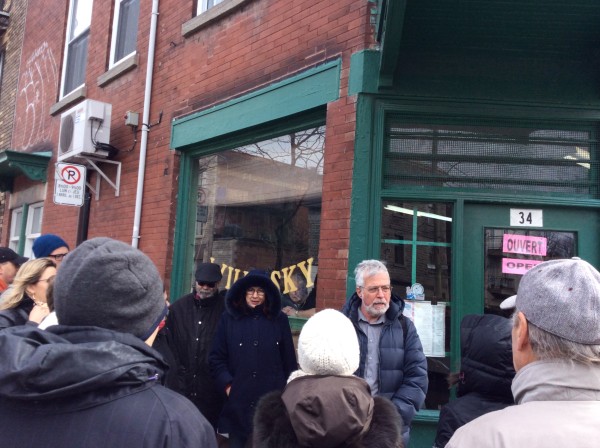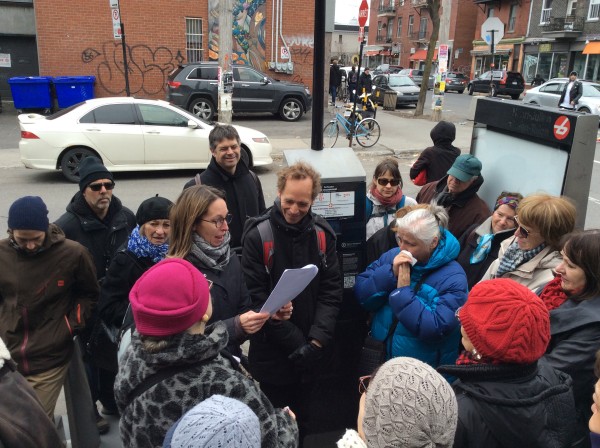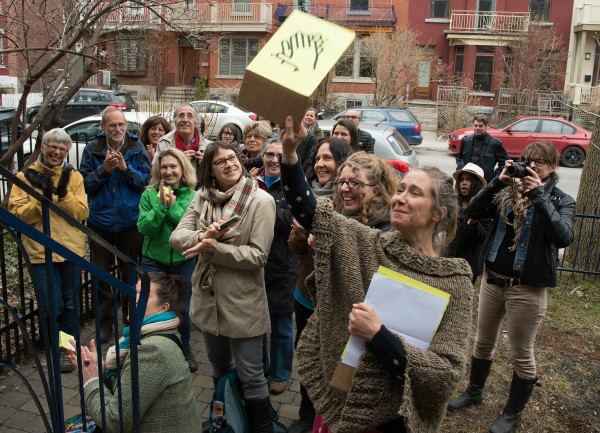We’re happy to announce that our very popular literary walking tour will be back, Sunday, June 7.
Meet us at parc Lahaie, in front of the Saint-Enfant-Jésus Church, 11 am. Voluntary Contribution. Meanwhile, you can read this account of our first tour.
_______________________________________________
A popular event
On April 25, 2015, Mile End Memories organized, at the request of the Blue Met / Métropolis Bleu International Literary Festival, a historical and literary walking tour of Mile End. About 60 people walked the streets of the neighbourhood to discover the sites and themes that inspired many Montreal writers, past and present.
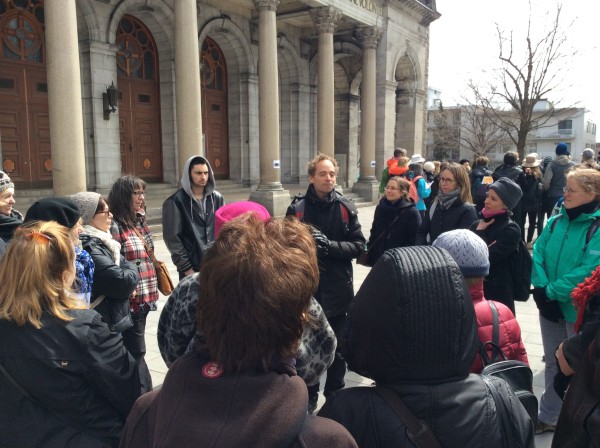
Justin Bur and Nathalie Tremblay, two of our guides during the tour, in front of the Saint-Enfant-Jésus Church.
The departure point was Lahaie Park, cradle of the Village de Saint-Louis du Mile End. After that, the walk continued along Saint-Laurent Boulevard, Canada’s historic immigration corridor. Its bars and restaurants—some trendy and luxurious, others infamous and seedy—have inspired many authors and filmmakers.
Walking along Fairmount Avenue between Saint-Laurent and Park Avenue, enabled us to present the time when the district was the heart of the Montreal Jewish life. The neighbourhood has always been – and remains today – a district of immigrants, where different cultures meet, intersect and overlap. Then, we looked at Saint-Viateur Street, the neighbourhood’s social artery. Here, numerous love stories and encounters—both expected and unforeseen—have inspired several documentaries and fictional films.
Saint Michael’s Church, also on Saint-Viateur, is the best known symbol of the neighbourhood. Initially an Irish parish, it now welcomes people of Polish and Italian origins, With its Byzantine Revival Style, it is another example of the hybridism of culture and languages which is the focus of the Mile End identity. Many of the cafés of Saint-Viateur Street and Park Avenue are now the workplace of many of today’s authors, both award-winning and yet-to-be-published.
The last stop was at the crossroads of Park Avenue, near Outremont, where Hassidic Jews meet Québécois Anglophones and Francophones, old and recent immigrants: The newly renamed Mordecai-Richler Library. Its primarily French-language book collection, housed in a former Anglican Church, now bears the name of the neighbourhood’s most famous author. Here is another example of the superposing of cultures which are Mile End’s secret!
The 2015 edition of the Blue Metropolis Festival also created other activities in, and about, Mile End. Thanks to the Blue Metropolis Foundation, Patsy Van Roost created L’Innocence des objets/The Innocence of Objects, another way to discover the remarkable stories of your neighbours! We would also like to mention the very popular walking tour offered by Mordecai Richler’s biographer, Charles Foran, during the Festival.
Bibliography for the Historical and literary tour of Mile End
Here are the books referred to in the order they were mentioned during the tour. If only a French title is included, this is because no English translation has been published.
– Robert Maltais, Le curé du Mile End, Québec Amérique (2009)
– Pierre Flynn, Parc Lahaie, song from the album “Sur la terre” (2015)
– Mordecai Richler : Barney’s Version, Knopf Canada (1997); Le Monde de Barney, Albin Michel (2010); The Apprenticeship of Duddy Kravitz, Andre Deutsch (1959), reissued Penguin Modern Classics (2005); L’apprentissage de Duddy Kravitz, BQ (2006); St. Urbain’s Horseman, Knopf Canada (1966), reissued McClelland & Stewart (2001); Rue Saint-Urbain, BQ, 2001; The Street, McClelland & Stewart (1969), reissued 2002.
– Andrée Maillet, Nouvelles montréalaises, Librairie Beauchemin (1966)
– Michel Tremblay, Des nouvelles d’Édouard, Leméac (1984) News from Édouard, Talon Books, 2000.
– Pierre-Marc Drouin, Mile End Stories, un roman, Québec-Amérique (2011)
– Ted Kotcheff (réalisateur), The Apprenticeship of Duddy Kravitz, film (1974)
– Michel Hellman, Mile End, Pow Pow (2011)
– Mike Gutwillig, From the Heart, Prize Publications (1967)
– Mordecai Richler, “St. Urbain Street Then and Now”, in Home Sweet Home: My Canadian Album, McClelland and Stewart (1984). A 1975 CBC television interview demonstrates his appreciation for Mile End.
– A. M. Klein, The Second Scroll, McClelland & Stewart (1961), reissued University of Toronto Press (2001); Le second rouleau, Boréal (1990)
– William Weintraub, “A Third Solitude”, in City unique : Montreal Days and Nights in the 1940s and ’50s, McClelland & Stewart (1996)
– Pascal Henrard et Hélène Meunier, Madame Coquelicot, Éditions du Phoenix (2013)
– Sherry Simon, “Diasporic Translation: Klein in Mile End”, in Translating Montreal: episodes in the life of a divided city, Sherry Simon, McGill-Queen’s University Press (2006)
– Jean-François Lesage (director), Conte du Mile End/A Mile End Tale, documentaire (2013)
– Maxime Giroux, Felix et Meira, film (2015)
– Malka Zipora, Lekhaim ! Chroniques de la vie hassidique à Montréal, BQ (2006)
– Sean Michaels, Us Conductors: in which I seek the heart of Clara Rockmore, my one true love, finest theremin player the world will ever know, Random House Canada, (2014)
– Myriam Beaudoin, Hadassa, Leméac (2006)
– Nicole Dickner, Nikolski, Alto (2005); Nikolski, Vintage Canada (2009)
– Don Bell, “Saturday Night at the Bagel Factory”, Weekend Magazine (19 avril 1969)
– Monique Proulx, Les Aurores montréales, Boréal (1996) Aurora Montrealis, Douglas & McIntyre, (1997) ; Ce qu’il reste de moi, Boréal (2015)
– Abla Farhoud, Le sourire de la petite juive, VLB (2011)
– Mordecai Richler, “Why I write”, Shoveling trouble, McClelland & Stewart (1972); “Pourquoi j’écris”, Survivre, etc, Anatolia, 2008.
Other authors and works inspired by Mile End
During our all too brief tour, we couldn’t mention all authors whose literary works evoke or portray the neighbourhood. Here are some examples:
- Noah et Rae Bernamof, The Mile End Cookbook, Clarkson Potter Publishers (2012)
- Justin Bur, Yves Desjardins, Jean-Claude Robert, Bernard Vallée et Joshua Wolfe, Dictionnaire historique du Plateau Mont-Royal, Écosociété (2017)
- Jorge Camarotti, Chroniques du Mile End Chronicles, Cardinal (2017)
- Bill Davis, The 80 Goes to Sparta, documentaire, ONF (1969)
- Yves Desjardins, Histoire du Mile End, Septentrion (2017)
- George Ellenbogen, A Stone in my Shoe. In Search of a Neighbourhood, Vehicule Press (2013
- Yannick-B. Gélinas, From Montreal, documentaire, Eurêka ! Productions (2010)
- Jacques Giraldeau, Les fleurs, c’est pour Rosemont, documentaire, ONF (1969)
- Pascal Girard, La collectionneuse, La pastèque (2014) ; Rebecca et Lucie mènent l’enquête, La Pastèque (2021)
- Jacques Goldstyn, Les étoiles, La Pastèque (2019)
- Adam Gollner, The Fruit Hunters: a story of nature, adventure, commerce and obsession, Anchor Canada (2009)
- Taras Grescoe, Sacré Blues, MacFarlane, Walter & Ross (2000); VLB (2003)
- Joseph Kadar, Lies my Father Told Me, film (1975) (Inspiré par une nouvelle du même titre publiée en 1949 par Ted Allan.)
- Kaie Kellough, Accordéon, Arbeiter Ring Publishing (2016)
- Albert Kish, Our Street Was Paved with Gold, documentaire, ONF (1973)
- Irving Layton, Waiting For The Messiah, McClelland & Stewart (1985)
- Sean Michaels, The Wagers, Penguin Random House Canada (2019)
- Guillaume Morissette, New Tab, Véhicule Press (2014) ; Nouvel onglet, Boréal (2016)
- Saleema Nawaz, Bone and Bread, House of Anasi (2013)
- Francine Noël, Babel, prise deux ou nous avons tous découvert l’Amérique, VLB (1990)
- Catherine Ocelot, La vie d’artiste, Mécanique générale (2018)
- Heather O’Neil, The Lonely Hearts Hotel, Harper Collins (2017) ; Hôtel Lonely Hearts, Alto (2018)
- Rafaël Ouellet, Gurov et Anna, film (2015)
- Chantal Ringuet, À la découverte du Montréal yiddish, Fides (2011)
- Sigal Samuel, The Mystics of Mile End, Freehand Books (2015)
- Magali Sauves, 160 rue Saint-Viateur Ouest, Mémoire d’encrier (2018)
- Gail Scott, Heroine, Coach House Press (1987); The Obituary, Coach House Press (2010)
- Trifiatis Tassia, Judas, Leméac (2007)
- Lise Tremblay, La danse juive, Leméac (1999); Mile End (version anglaise), Talonbooks (2002)
